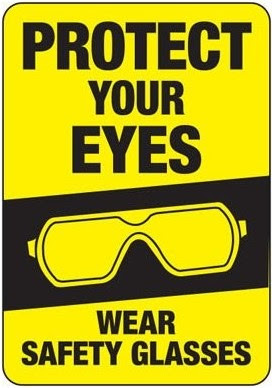Eye Safety: Protecting Your
Vision in the Workplace
Eye
Safety: Protecting Your Vision in the Workplace
Eye
are precious to every human. Eye injuries are a leading cause of workplace
accidents and can result in permanent vision loss in some cases. Whether you
work in construction, manufacturing, or any another industry, it is essential
to take eye safety seriously and protect your eyes from potential hazards that
damage your vision. Here are ten tips for eye safety in the workplace.
Wear
Appropriate Eye Protection – Personal Protective Equipment(PPE)
The
basic defense against eye injuries is wearing appropriate eye protection. This
can include safety glasses, goggles, face shields, or a combination of these. Choose
eye protection that is specifically designed for your work environment and the
potential hazards you may face. The correct fitting of PPE is very important for
protection the eye effectively from the potential hazards.
Assessing
the Risk by conducting the Risk Assessment(RA)
Before
starting any work, assess the risk for eye hazards. This includes identifying
potential hazards such as flying debris, chemicals, or intense light. Once you
have identified the potential hazards, you can take necessary control measures
to protect your eyes, such as wearing the appropriate eye protection or taking
steps to control the hazard.
Health Hazard – Blue | NFPA Hazard Diamond
Using
all required Personal Protective Equipment
In
addition to wearing appropriate eye protection, employee may also need to use
other personal protective equipment to safeguard your eyes. For example, if you
work with chemicals, you may need to wear a face shield in addition to safety
glasses to protect your eyes from splashes.
Follow
the Standard Procedures
Follow
the standard procedures when using equipment or machinery. This includes
following manufacturer's instructions, conducting regular maintenance checks,
and adhering to established safety protocols. Standard procedures can help to
minimize the risk of eye injuries and ensure the equipment is functioning
correctly.
Ensure
using the Right Light Sources
Intense
light sources, such as arc welding or laser cutting, can cause significant
damage to your eyes. To protect your eyes, use the appropriate light source for
the task at hand and take steps to control the intensity of the light. Periodic
break is also important in such activity to safeguard the eyes.
Avoid
Rubbing Your Eyes
Rubbing
your eyes can introduce foreign objects into your eye, increasing the risk of
eye injury. If you get something in your eye, rinse it out with water rather
than rubbing it.
Safety in Handling of Hazardous Materials
Be
Careful When Removing Contacts
If
you wear contacts, be careful when removing them. Do not pull on the contacts
or use your fingernails to remove them, as this can scratch your eye and
increase the risk of infection.
Use
Protective Eyewear for Sports
If
you participate in sports, use protective eyewear to safeguard your eyes. This
can include goggles, helmets with face guards, or other forms of protective
eyewear.
Safely
Store the Chemicals
Chemical
exposure/contact may result into serious eye injury, in some cases in leads
loss of vision. If you work with chemicals, store them safely to minimize the
risk of eye exposure. This includes storing chemicals in their original
containers and keeping them out of reach of children.
Get
Regular Eye Checkups
Finally,
it is important to get regular eye exams to ensure your eyes are healthy. This
can help to identify any potential eye problems early and minimize the risk of
permanent vision loss.
In
conclusion, eye safety is critical to protecting your vision and preventing
permanent eye injuries. By following these tips and best practices, you can
help to keep your eyes safe while at work and during leisure activities.
Regular eye exams, wearing appropriate eye protection, and following
established safety procedures are key to ensuring eye safety in the workplace.
Part 3 - Construction Safety Pictorial Guidelines
Eye
safety, workplace, vision, construction, manufacturing, hazards, eye
protection, safety glasses, goggles, face shields, risk, chemicals, light
sources, rubbing, contacts, sports, protective eyewear, chemical storage, eye
exams, permanent vision loss, prevention.
CONFINED SPACE STANDBY PERSON RESPONSIBILITIES





No comments:
Post a Comment